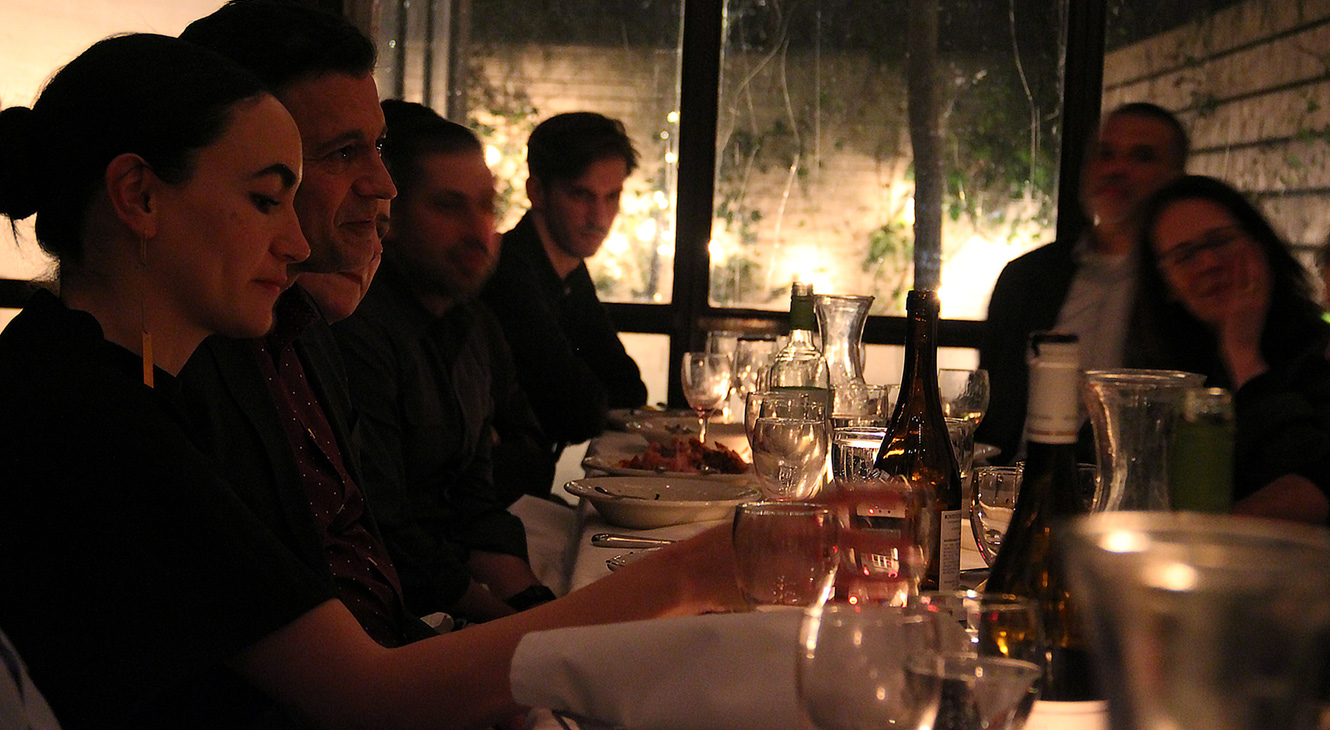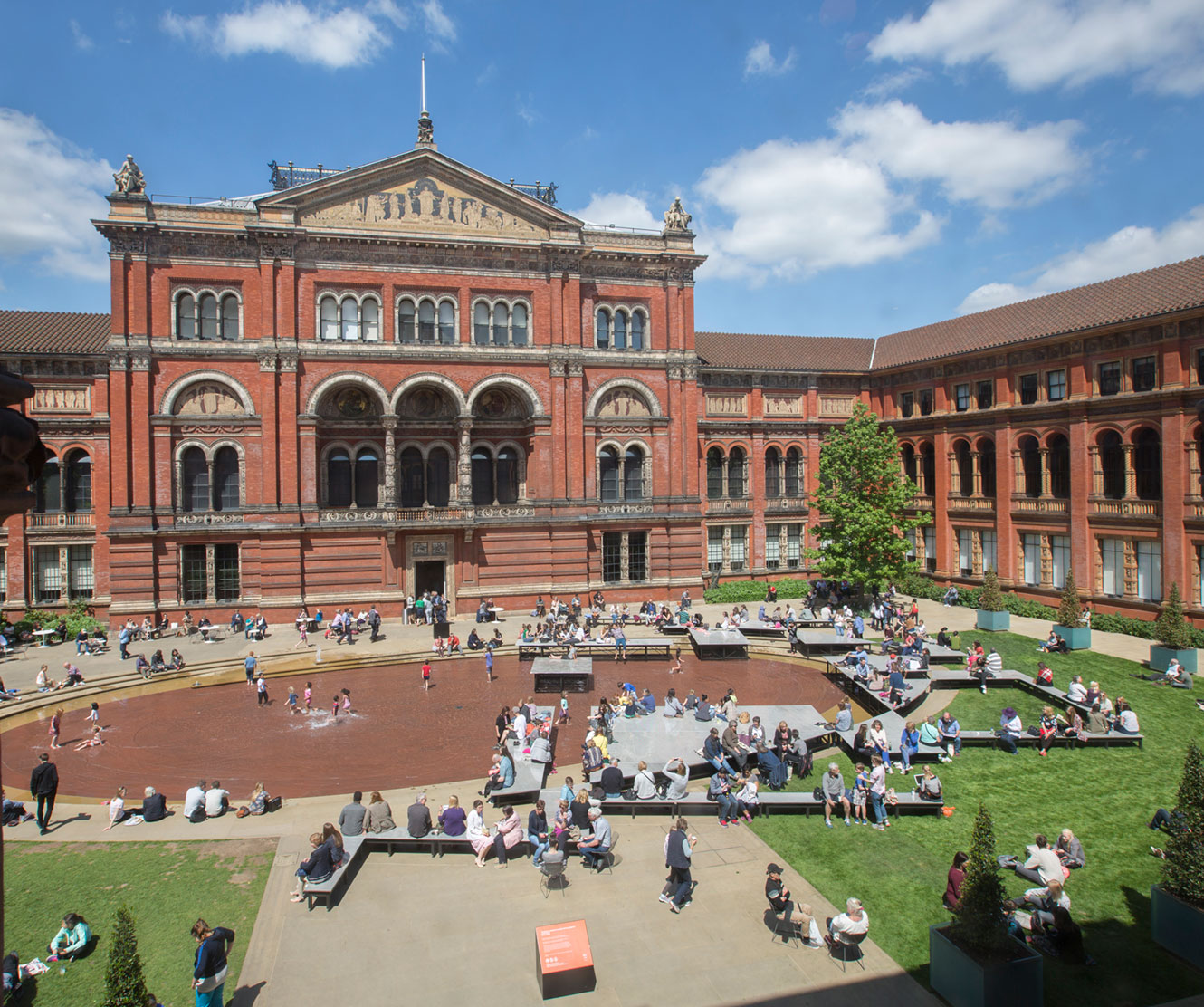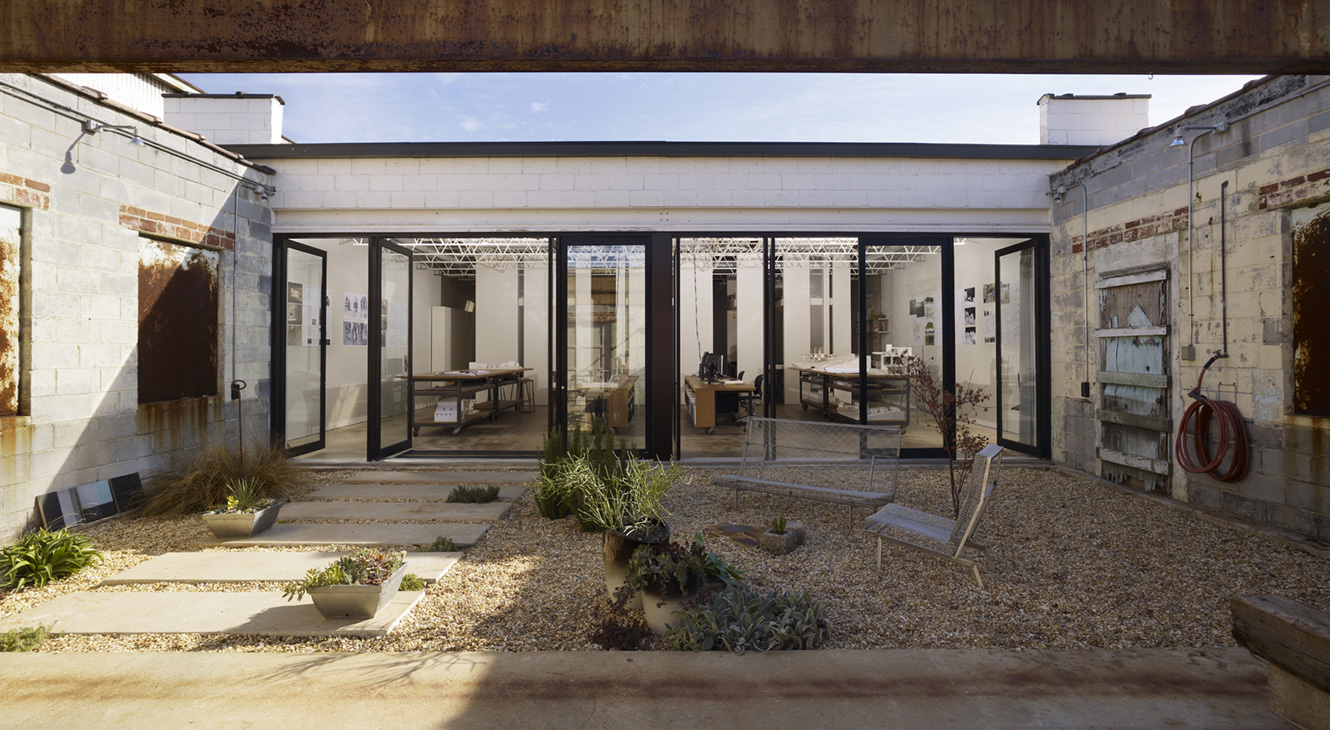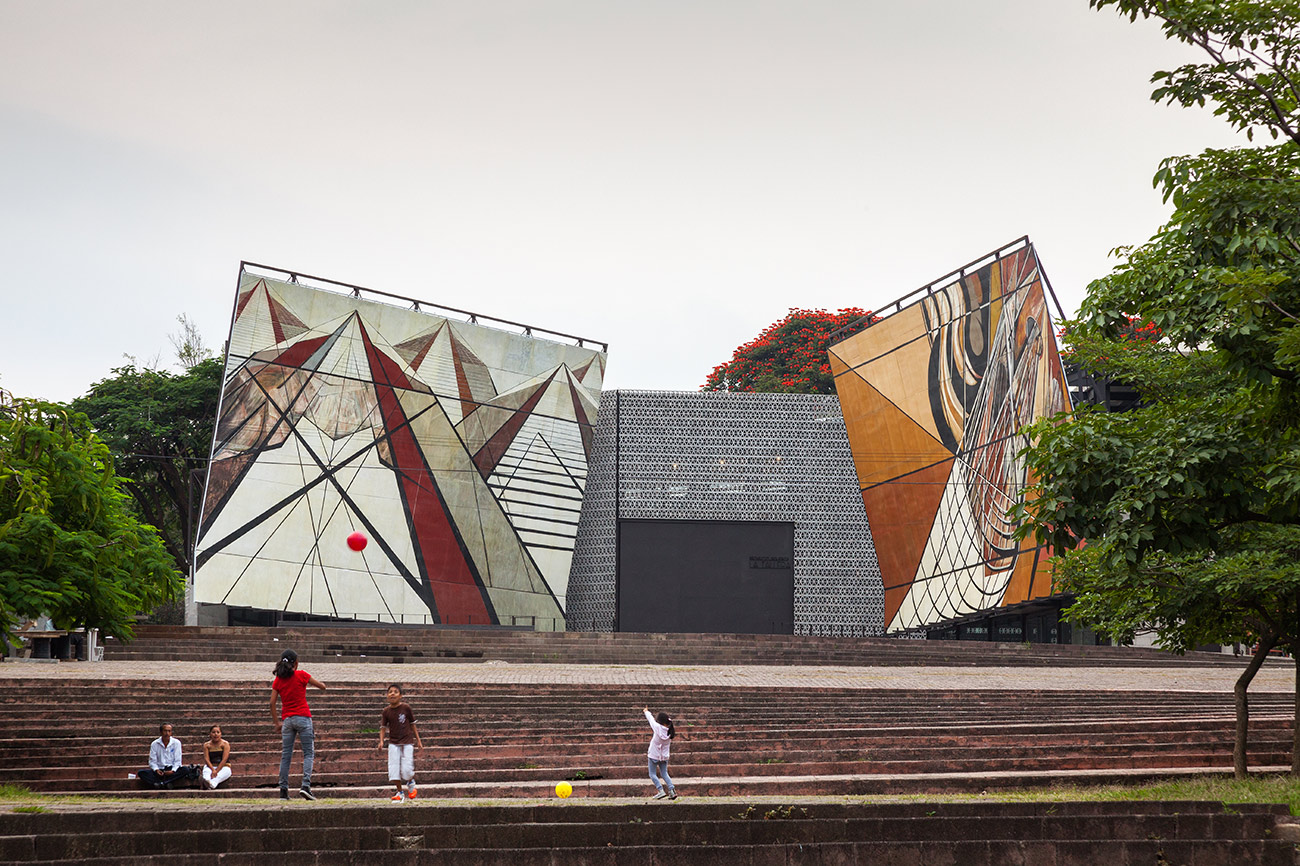On the table: Dinner with Frida Escobedo, Brian Bell, & David Yocum
A roundtable discussion featuring three winners of the 2017 Emerging Voices prize.
March 15, 2018

Frida Escobedo (left), Sunil Bald (second from left), and others at an Emerging Voices dinner.
The League’s annual Emerging Voices program recognizes eight firms with distinct design voices. In March and April, each firm delivers a lecture, then joins prominent architects, critics, and others in the industry for dinner and informal discussion.
In the following, Frida Escobedo of Mexico City–based Taller de Arquitectura, Brian Bell and David Yocum of Atlanta-based BLDGS, and others discuss subjects, objects, and representation.
Sunil Bald, studioSUMO: Something that I felt about both firms’ work was a conscious flip between architecture-as-object and architecture-as-subject. How do you see the way that you privilege architecture-as-subject over architecture-as-object as an act of resistance, either within the practice or within the built environment at large?
Brian Bell, BLDGS: Resistance is a really loaded term right now, as it should be. We have always seen our practice as a way to – and I hate to use this overused word – disturb and cause people to see the world around them in a new way. As a student, I remember the idea that architecture could resist corporate culture – there was an artistic practice and a corporate practice. And I think we have moved beyond that right now. I’m not sure how really, but there’s nothing on the table. I think it’s important that we consider how architecture can change that.
Frida Escobedo, Taller de Arquitectura: I completely agree. Maybe it’s not about the big changes, but rather it’s about everyday practice. How do we question our work? And then how we can slowly shift in a different direction?
Bald: I found those smaller operations really interesting in your work, Frida. I would say, to use an analogy, that you were almost more interested in the word than the text, and by doing so the words could be recombined to create their own chance associations rather than a larger master narrative, which is then translated into a way of making.

Frida Escobedo, Taller de Arquitectura | "You Know, You Cannot See Yourself So Well as by Reflection," installation, Victoria & Albert Museum, London, UK, 2015. Credit: Victoria & Albert Museum
Escobedo: I think this way of making things, through the process, is in itself a result. Every time I get a commission that’s outside of Mexico City, I ask myself: How would I do this if it were in Mexico? How can I shift this? How can I keep craft traditions in my work? Maybe there is only a small opportunity to do so, but that’s the crack in the system that I’m trying to find. Or sometimes it has to be something that is not perfectly finished, because it cannot be. Or it needs to be something that ages well, because it cannot be well maintained. This kind of understanding is what opens up opportunity and produces a different kind of reality for me.
Bald: Both firms are so directly involved in the act of making itself – and there’s also a very close connection to labor in the work.
David Yocum, BLDGS: It’s very hard to think about our practice without thinking about how we are directly involved in the making of the work. You saw images of our office, which we affectionately call Villa de Murph, as if there could ever be a warehouse along train tracks called a villa.
But it was a project that took five years of personal labor, discovering facts on the ground. We have a very short attention span for imported, superficial ideas, and instead we devote our attention to the context, the historic, all that came before us, so that we can discover what’s there. I think the political act is actually one that questions our own authority and instead lends credence to all that is around us. It’s really a questioning of ourselves before we act; our own kind of internal debate and our own resistance. We’re very hesitant to bring things to a project until we feel like we’ve comprehended all of the intentions that are already there, out of respect.
Eric Bunge, nARCHITECTS: When we talk about politics in architecture, we need to unpack some terms, like intention, process, and result. One can have a political intention that doesn’t necessarily carry consequence. Or one can inherently make implicit political actions but unknowingly. So in a sense, if you also unpack the term site, whether it’s Frida interfering with other practices, or other aspects that are cultural or physical, like in La Tallera Siqueiros, you are revealing, through these interventions, context, which is inherently political. You have a very clear position about that reality and you reframe it.
Even if you, Frida, couldn’t take the actual earth from Mexico to Oslo, as you intended to in your installation at the Oslo Architecture Triennale.
Georgeen Theodore, Interboro Partners: It was wonderful to see that your practices really emerged out of the specific conditions in which you work and the cultural practices you engage. And I am amazed and excited by the drawings, as they’re so different between the two offices. I’m curious to hear you talk about your roots, maybe through the lens of drawing.
Escobedo: Presentation in architecture is always a big topic. But in the past few years, I’ve learned to let go and accept the form of representation proposed by those in my office, because the conversation is about something else. To me, it’s more about the references or the context or the constellations of objects or the ideas that come to place. I’m more interested in the material palette and the social information that happens within architecture than the representation of it, which I think is more volatile or fleeting.
Bell: I see this in our students’ work. I think of our drawing often as control of geometry – it’s a tool that allows us to align intention. We often think of it as the ink or the toner on a page, but for us, it’s a tool that helps formulate what we want to do and where we want to take something. So we use drawing heavily in our office.
Mario Gooden, Huff + Gooden Architects: I’d actually like to get back to the question of politics, but as it relates to drawing and representation. I think there’s also a politics in relation to the practice of architecture in your work. Neither of your offices use hyper-realistic representation in terms of the production of images, which, it seems, the profession has actually wholeheartedly bought into, in terms of marketing, in terms of saying “Well this is what the client wants, we need to represent the work as realistically as possible.”
Yocum: We were just asked about roots. And so my confession tonight would be that I spent my entire college career just drawing, but not as an architecture student. I was a fine arts student who worked in printmaking. I spent four years just carving into copper and zinc plates and waiting to see the result. When I came to architecture, I moved away from drawings as things to be appreciated abstractly and objectively, and I very much became fascinated with drawing just as a tool. This speaks to what Brian mentioned earlier – in our practice, we intentionally do not make hyper-realistic renderings. We actually have a very tortured relationship with our output because we often say, “Well that’s not what we’re interested in even though we know the value of it.” So, sometimes we go in circles.
Mimi Hoang, nARCHITECTS: I want to come back to the subject-object question through your use of imagery. I was struck by how both offices use time lapse or time lapse–like imagery to reveal steps, or rather, to reveal indecision, almost. For example, the question of where to place the two murals in Frida’s La Tallera Siqueiros project, or the images of Brian and David by the wall at the Atlanta Contemporary Art Center – the refusal to rely on a single image is more about revealing the decision-making process, or a refusal to capture something in any sort of finished state. Frida’s Civic Stage project at the Lisbon Architecture Triennale even refuses to settle into any kind of fixed relationship.
Escobedo: I think there is an impossibility of the architectural object to be something definite and permanent. Architecture is always changing, always shifting. It’s never what it was supposed to be and it is never the same thing the following day. Drawing is a tool for thinking, and the representation is almost the possibility of the object, which then materializes into something completely different. We have shifted from this idea of having a beautiful, permanent object to something that is a little more flexible and fluid, with more possibilities. If we understand that, then we can open the scope of what architecture can be.
Gooden: Your projects operate not as object, but as edge or margin.
Escobedo: Perhaps architecture is not a precise line, but more like a shoreline. You never know where it is, but it has the same definition. You know where to find it, but you never know quite where its exact edge is.
Yocum: Something we’ve been talking about a lot lately is the refusal to believe that anything we do or work with is new. As architects, we take a set of prior intentions and rearrange them to say that our values have shifted as a culture or as a society or as a political group or as a client or as a person, and then we let them go. Then we move on to the next project. And so if you remove the idea that we’re making new things, we’re essentially reallocating energy and molecules and so on. We’re simply shifting the intention and then getting out of the way. That’s something we consciously talk about as a value system.
Rosalie Genevro, The Architectural League of New York: I am listening to the words that you and Frida are using, and trying to imagine what you’re expressing. And it strikes me that many of these ideas are implicit in landscape design. I wonder whether you are consciously aware of having been influenced by landscape design as a practice.
Escobedo: We’re not just architects – we are always contaminated by these other disciplines, whether it’s landscape, or art, or music, or literature, or mathematics. For us, there is an understanding of energy, of shifting, and that’s a positive thing. Nothing is fixed for me.
Bunge: In a way it’s endemic of our time – the expanded field of architecture. In addition, landscape architecture has become quite a dominant field in the last 15 or 20 years for many reasons. And now landscape architects are also architects. So I think that landscape is the most immediate, apparent expansion of the discipline.
Julio Salcedo, Scalar Architecture: But what I do find is a level of comfort in both offices with the scope and with the limitations of the practice. And that also addresses the question of your presentation – you’re working with a very specific set of tools, which have parameters and constraints.
Bald: I wonder where you see yourselves now. I know that these moments are often about self-reflection. Do you wonder about where you are and what you’re doing and what your voice is?
Yocum: I would venture to say that everybody at this table wonders on a daily basis what their voice is and where they’re going. I think we wake up and think: Where are we taking this today?
Bald: Then maybe the question is, Where would you like to take it?
Escobedo: This is something that I alluded to earlier: everyday practice. It’s about the two or three smaller questions every day. Who am I building a relationship with? How am I building a relationship with my partner? How am I building a relationship with my family? It’s about this much more complex diagram that turns you into a complete person because we’re not just architects, we’re people, too. I think you slowly grow to have a very strong set of preoccupations, things that guide you and support you, and eventually you learn to say this is what I’m interested in. This brings confidence when building your own practice, but that confidence doesn’t tell you what the next step would be. You have a stronger step, yes, but you’re still on uncertain terrain, and you don’t know where you’re going.
Bell: We’re constantly hoping for projects that have some kind of . . . some tooth, or power to shift the status quo, especially in our professional climate in Atlanta, which is honestly fairly conservative. And you can fight against that, you can make that your target, but in a way it’s a red herring. So, I think we’re looking for those kinds of projects that have some meaning to create – and this sounds prosaic – but a better place for people. A place where people want to live their lives and want to be, rather than a place where they’re always looking for the next thing. We’re looking for that project. How you choose your projects is so important as an architect – it is a political act, I would say.



